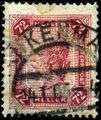Postage stamp reuse
The article outlines methods used in the design of postage stamps to avoid their fraudulent reuse (mainly by removing the postmark), attempted to avoid postage fees. It does not concern methods to limit the production of fake or forgery (rare) postage stamps to abuse the collectors.
Problem
The crux of the problem was the stamp paid the fee for a single usage of the mails, but the stamp itself tended to arrive at the destination in reasonably good condition; it would be the work of a moment to remove the stamp from the envelope and then attach it to another piece of mail after removal of the postmark. In the 19th century, the fee for sending a letter was often a significant percentage of a daily wage. Some enterprising individuals discovered that the postmark inks could be removed from the stamps, although they were assumed not water-soluble.
In many countries, such as the United States reuse of used stamps, cancelled or not, is illegal.[1]
Fixes
Mute cancellation (killer)
Since letters were already receiving postmarks, postal services began to position the postmark so as to mark the stamp as well. This is still the most common method of stamp defacement. In many countries the postmark even comes in two parts; the location/date circle, and the "killer" in which a handstamp marked the postage stamps.

Grilling
In the United States, the experiment of grilling was tried in 1867, where tiny squares were embossed into the paper after the stamp was printed, the idea being that this would break up the paper fibers and let more ink be absorbed into the paper. But this also made the stamps more prone to tearing, and grilling was abandoned around 1871. The more unusual types of grills are now among the great rarities of US stamps.
Design with water-soluble inks
In Great Britain, the 1880s saw the use of inks which were water-soluble, thus preventing washing altogether. Only lilac and green colors were available. This scheme was abandoned after a few years, and the few surviving unwashed stamps have become collectibles.
Surface coating
Later experiments involved surface coatings. Between 1901 and 1907 Austria applied varnish bars, thin diagonal strips of varnish, to the paper before printing the design. Russia did the same between 1909 and 1915, applying the varnish in a pattern of lozenges. In both cases the (not very convincing) theory was the same; the ink of the printed design would not soak into the varnish, so that in the washing process the design would tend to flake off, forming a telltale pattern on the washed stamp. The United States also coated a few of their $1 revenue stamps with varnish around the turn of the 20th century.
Perfin
A perfin is a stamp that has had initials or a name perforated across it to discourage theft. By agreement with postal authorities, a perfin stamp on a letter could be used only by the owner of the perfin. Therefore, a stolen perforated stamp would be of no value to the unauthorized bearer.
Varia
More unusual methods have included tearing or slicing the stamp, but this is a slower process and can easily damage the contents, and was only occasionally used. An example is 19th-century Afghanistan, where cancellation involved the removal of part of the stamp rather than applying ink or other surface marking.
-

50 heller 1901 unused stamps of Austria, normal and with varnish bars
-

1904 stamp of Austria, showing varnish bars after washing
References
- ↑ "Poster 5 - Warning - Reusing Postage". United States Postal Service. 5 July 2005. Retrieved 4 June 2015.
- Leon Norman Williams, Fundamentals of Philately (American Philatelic Society, 1990) ISBN 0-933580-13-4
- Scott catalogue
- Stanley Gibbons catalogue